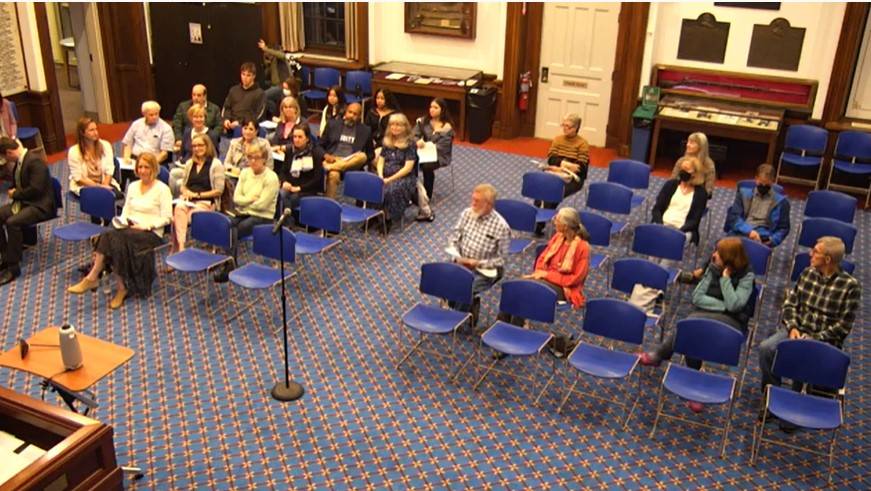Andover has had three official town seals since 1899, with each depicting an image of an Indigenous person that is, at best, inaccurate.
Last fall, Andover joined several other Massachusetts towns that have reconsidered Native American imagery on their town seals when the select board appointed a Town Seal Review Committee to reevaluate the seal Andover has used since 1951, collect public input and, if warranted, propose a new seal for town meeting approval. On Wednesday, the committee held its first public forum, which was described as its “first opportunity….to hear in-person input.”
“This is part of a process,” Committee Chair Karen Van Welden-Herman told about 30 people who gathered at Memorial Hall Library for the meeting. “We’re here to listen to you…and factor that into what we do going forward. This is still very much a mobile investigation.”
The committee’s survey earlier this year drew 1,818 responses that showed people were almost evenly split on whether the town needed to update its seal, which it is required to have under state law. But comments from the survey Assistant Town Manager Austin Simko shared at the forum suggested both sides wanted to honor the people who lived in the region before Andover was settled by colonists in 1636 and incorporated in 1646.

“It bothers me that we have an indigenous person on seal when we all know the history,” wrote one respondent who supported a change. “I like that the seal recognizes Native Americans played a significant role in the founding of towns in Massachusetts,” wrote another respondent, who supported keeping the current seal.
“We hear these narratives — we still want to honor these people,” said Paul Pouliot, a Native American historian from New Hampshire. “We don’t try to push any of these narratives. It’s up to community to decide what to do, but it’s definitely inaccurate.”
The committee invited Paul and Denise Pouliot, the head male and female speakers of the Pennacook Band of Abenaki People, to address the forum. The Pouliots have advised other Massachusetts towns that reviewed and updated seals that had Native American imagery.
“When we look at these town seals, it’s very clear they happened after westward expansion because the figure is naked and has a headdress and a war bonnet,” Paul Pouliot said. “This was not our culture. It was always a misappropriation by western culture.”
Elaine Clements of the Andover Center For History and Culture, who also serves on the committee, said Andover’s seal depicts Cutshamache, a Pennacook leader who appeared in court in Boston on May 16, 1646, to acknowledge he had sold the land that became Andover to John Woodbridge for six pounds, a coat and the right for Pennacook people to continue fishing in the area. The image of Cutshamache adopted when Andover updated its seal in 1899 was based on the design in a pin a local jeweler sold for the town’s 250th anniversary in 1896. That first seal was designed by William Foster, who was 13 at the time and went on to become an artist.
Clements said the seal was updated again in 1906 by local photographer Leonard Sherman. The current seal, adopted in 1951, was designed by Ethel Coolidge. The seal still seen on town vehicles was adapted by 3M Co. in 1965, but is not the town’s official seal. In 1995 Krisoffel Meulan designed a new seal that was aimed at depicting Cutshamache more accurately for the town’s 350th Anniversary.
Cutshamache, however, was from what is now Nashua, NH and may not have even represented the community where he was giving away the land, Paul Pouliot said. “It’s like the real estate agent came through and sold the land without consulting the landowners, and that’s probably what happened in Andover,” he said.
He also said Indigenous people living in the region in the 17th century did not understand the concept of land ownership, a fact that was often exploited by British settlers.
“Cutshamache is much less important to the founding of Andover,” Clements said. “The story of the founding of Andover, and the relationships between the native people and the English settlers, needs to be told in all of its complexity and nuance. It’s a complicated story about the clash of cultures that”s much bigger than what’s recorded in the 1646 documents…How and where the story is told is really our next challenge.”
The Pouliots suggested adopting a seal that does not use any imagery of a person may be the easiest way to avoid controversy.
“I think you’re going in right direction in looking at all these images,” Paul Pouliot said. “It seems like that image was consistently misappropriated for New England.”

